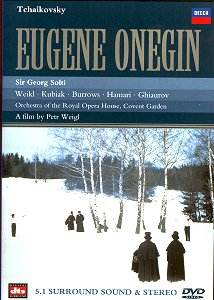There seem to be two basic approaches to the filming
of opera. The most common and, to my mind, most successful, is to film
actually in the opera house, whether live or without the audience. Even
with technical inadequacies, what we generally get is a true record
of a genuine production, with singers caught on the wing and a feeling
of experiencing the opera where it was meant to be. The other approach,
much less common, is to make a true feature film, complete with exotic
locations and, where needed, a cast of thousands. This method can have
patchy results, particularly when the cast have to mime to a soundtrack.
At its best (say in the Losey Don Giovanni or Zefirelli La
Traviata) there is an epic sweep that serves the piece well, and
there is no hint of tiredness in voices that one might get in the theatre.
The syncronisation of voices is always a problem, but at least the cast
are usually miming to their own voices, which is where the problems
in this Eugene Onegin really start.
Petr Weigl chose to go on location to Prague and its
magnificent surrounding countryside, and make a true ‘film’ of Tchaikovsky’s
masterpiece. He misses out the prelude (considered unnecessary and reduced
to a caption over the music) and starts with a grand, panning vista,
the peasant chorus emerging from the distance. This is fine until the
principal characters have their opening entries. In Weigl’s film, all
are actors, and it has to be said they all look the part, particularly
the women, who are stunning. As soon as they open their mouths, the
whole thing becomes virtually unwatchable. Whatever attempt was made
to match in to Solti’s famous Covent Garden recording was simply not
good enough. Time and again, lip movements do not match the singing
and, more seriously, the emotions of the singers’ performances are completely
undermined. Take Tatyana’s famous letter scene. It is filmed in a sumptuous
interior, with camera gently following her and closing in on facial
expressions. But she simply mouths the words with no emotion (or rather
her own, not the singer’s), and the great climax, with Kubiak’s soaring
soprano declaiming passionately, is played by the actress with her head
buried down in the paper! Likewise, Lensky’s melancholy aria before
his duel is set in a stunning Bergmanesque ‘snowscape’, but the actor
simply does not convince us he is singing Stuart Burrows’s part.
I guess all this may bother some less than me. I certainly
would not want to see ‘ham miming’ to opera singing, but Weigl has obviously
gone for a sort of laid back, method approach with his actors that might
work in a play but does not square at all with what we are hearing.
The whole thing looks great, with predictable panache in the ballroom
scenes and magnificent locations, but this approach to the filming of
opera was doomed from the start without real singers and their own soundtrack.
This Onegin is good to look at, and great to listen to, but not
both. My advice would be to just listen to the Solti discs and wait
for a ‘proper’ production to come out on DVD.
Tony Haywood
